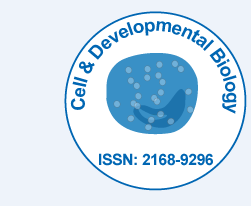
Cell & Developmental Biology
Open Access
ISSN: 2168-9296
+44 1478 350008

ISSN: 2168-9296
+44 1478 350008
Short Communication - (2021)Volume 10, Issue 4
Cells must eliminate and take in bigger molecules and particles in addition to transporting tiny ions and molecules through the membrane. Even complete unicellular bacteria can be engulfed by some cells. You may have accurately assumed that the cell needs energy to take in and release big particles
Endocytosis and exocytosis are the two basic methods for transporting these big particles.
Endocytosis is a sort of active transport that transports particles into a cell, such as big molecules, cell components, and even complete cells. Endocytosis comes in many forms, but they all have one thing in common: the cell's plasma membrane invaginates, establishing a pocket around the target particle. The particle is confined in a newly formed pocket after the pocket pinches off. Phagocytosis (sometimes known as "cell devouring") is the process by which a cell takes in big particles such as cells or comparably large particles. When bacteria infiltrate the human body, for example, a type of white blood cell known as a neutrophil will eliminate the intruders by engulfing and encircling the microorganism, which is subsequently destroyed by the neutrophil [1].
Pinocytosis is a variant of endocytosis. This literally means "cell sipping," and it was named at a time when it was assumed that the cell was taking in extracellular fluid on purpose. In reality, this is a process that draws chemicals from the extracellular fluid, including water,that the cell need. Pinocytosis produces a considerably smaller vesicle than phagocytosis, and it does not require the vesicle to join with a lysosome. Potocytosis is a variant of pinocytosis. On the cytoplasmic side of the plasma membrane, a coating protein called caveolin, which functions similarly to clathrin, is used in this process. In addition to caveolin, the cavities in the plasma membrane that create the vacuoles contain membrane receptors and lipid rafts [2].
In a targeted kind of endocytosis, receptor proteins in the plasma membrane bind to certain molecules with a specified affinity. Clathrin is linked to the cytoplasmic side of the plasma membrane in receptor-mediated endocytosis, just as it is in phagocytosis. If receptor-mediated endocytosis is required for chemical uptake and the process is unsuccessful, the substance will not be taken from tissue fluids or blood. Rather, it will remain in those fluids and become more concentrated. Failure of receptor-mediated endocytosis causes some human illnesses. Receptor-mediated endocytosis, for example, removes the cholesterol type known as low-density lipoprotein or LDL (commonly known as "bad" cholesterol) from the bloodstream. The LDL receptors are faulty or absent in the human hereditary illness familial hypercholesterolemia
Exocytosis is the process of transferring material into a cell in the opposite direction. Exocytosis is the polar opposite of the activities mentioned in the previous section, with the goal of ejecting material from the cell into the extracellular fluid. Waste material is encased in a membrane that merges with the plasma membranes inside. The membranous envelope on the outside of the c opens as a result of this fusion. The release of extracellular matrix proteins and the secretion of neurotransmitters into the synaptic cleft by synaptic vesicles are two further instances of cells releasing chemicals via exocytosis [3].
Citation: Anadia Z (2021). Cells key Mechanisms for Importing and Exporting Macromolecules. Cell Dev Biol. 10:231
Received: 06-Jul-2021 Accepted: 20-Jul-2021 Published: 27-Jul-2021 , DOI: 10.35248/2168-9296.21.10.231
Copyright: © 2021 Anadia Z. This is an open-access article distributed under the terms of the Creative Commons Attribution License, which permits unrestricted use, distribution, and reproduction in any medium, provided the original author and source are credited.